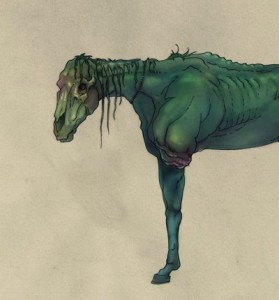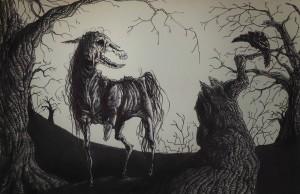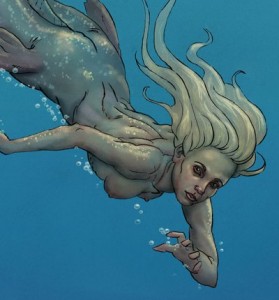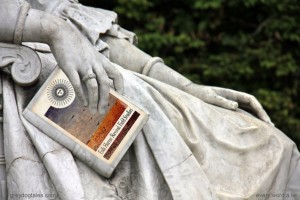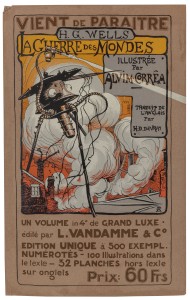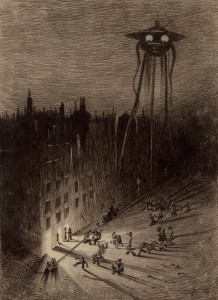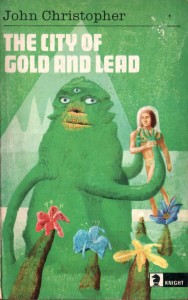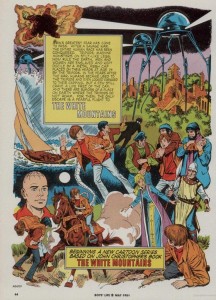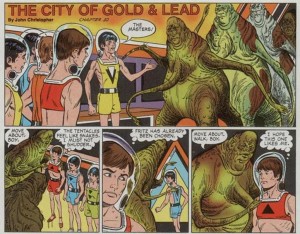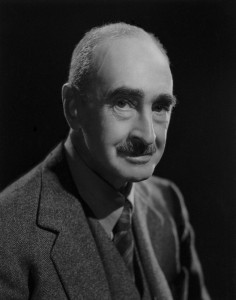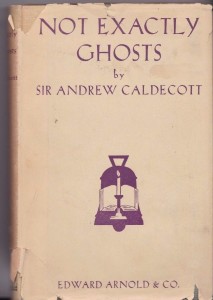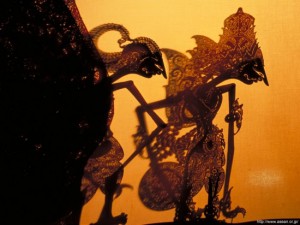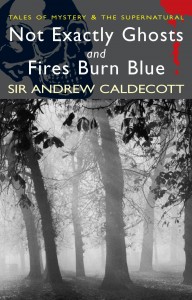Weird art today, longdogs in the mid-week(ish) and horror fiction by Saturday. We’re careening all over the place at the moment, which means that we’re both ‘moving swiftly and erratically’ and ‘being hauled over for repairs’. Lots of background and menu bits to freshen up, basically. We did think about going wild and becoming the Internet’s premiere ‘Nice Pussycat Photos and Enid Blyton Tribute’ blog, but then we felt slightly ill. So we won’t do that. Lurchers and creepy stuff must prevail.
The Horror out of Toytown has its appeal though….
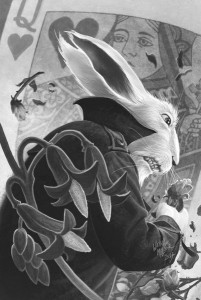
As promised, we now have our interview with that most excellent artist friend of ours, M Wayne Miller. Instead of some made-up introduction, we quote from his bio at Dark Renaissance Books, for whom he has done many covers and illustrations:
“M. Wayne Miller made his mark in the 90’s as a consummate b/w illustrator for numerous book and magazine publishers as well as several role-playing game publishers. While the b/w market was a fine place to cut one’s freelance illustrator’s teeth, and he did well, it was a stepping-stone to the more competitive and lucrative color illustration market. After an artistic conversion to color work, Wayne re-emerged as a cover illustrator for specialty press and mass-market book publishers, as well as for role playing games, online publications, and private commissions.”
For us, Wayne’s work is particularly fun because he captures the ‘full-on’ action style which represents weird adventure at its best, and what they used to call a rollicking good story. Let’s hear from The Man (the art below should be clickable for larger versions – possibly):
greydog: Welcome to greydogtales, Wayne. We’ve been looking forward to having you here, as many of our listeners will know you from your cover art for so many weird and horror books. Was working in that genre a personal choice or one driven by the market?
mwm: Horror has always been a genre I enjoyed in both narrative and visual format. As a kid I loved old b/w movies late at night such as The Creature From the Black Lagoon, The Giant Claw, and The Black Scorpion. Of course there was Godzilla, and all the giant monster movies, as well as the creepy sci-fi stuff like Forbidden Planet and The War of the Worlds (the original, of course). My reading followed in this vein, though it was middle school and high school before I really got into much actual horror. I blame Stephen King for making me an avid horror reader. In the years since, I have continued to read and watch horror fare, so one would be safe in saying that I was seasoned and simmered in the genre through my formative years, which I have no doubt led to my enjoyment in creating such artwork.
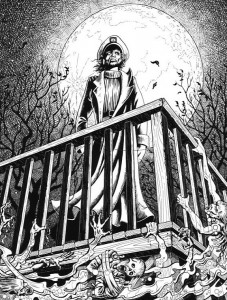
With regard to my illustration career, I would say the market provided the opportunity. My first published illustration appeared in Deathrealm magazine in 1995. From there I went on to have work appear in lots of other horror genre periodicals and story collections. Like stepping stones, one led to another, and momentum was achieved. Once my cover illustrations began to appear on Dark Regions Press publications, cover opportunities came my way. I won’t go as far as to say I am typecast as a horror illustrator, but for many years, that is exclusively where I worked. As with most things, times change, so much of the horror work has fallen away, replaced by fantasy and sci-fi.
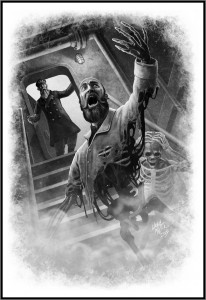
greydog: We interviewed Willie Meikle here last month, and of course you’ve illustrated many of his stories, particularly his Carnacki pieces. Are you a fan of William Hope Hodgson?
mwm: Yes indeed. Willie and I have worked together on countless projects. He is hands down the writer I have worked with the most in my career. We often joke that we are a tag team, and unbeatable as such. One of the things I love about Willie’s work is that he takes characters like Carnacki, Sherlock Holmes, and Professor Challenger, and writes new fiction that is every bit as authentic as the original works featuring these characters, with the added spice of lots of supernatural happenings and creepy monsters. And yes, I am a fan of William Hope Hodgson, as well as Sir Arthur Conan Doyle, so doing artwork based on these writer’s legacy is a special treat for me.
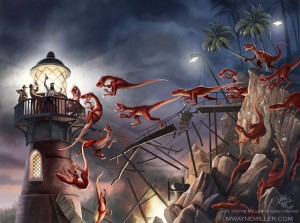
greydog: We’ve seen a wide range of sketches, monochrome pictures and glorious technicolour pieces from you. What’s your own favourite medium?
mwm: If by favourite medium, you mean the one I use most often, digital is my thing. All of my published work for hire, outside of a very few in the beginning, is digital. That meaning that I do my sketching, concepting, and refined drawing with pencil and paper, and all finished painting whether monochrome or colour, in the computer. While I do all my painting digitally, I honestly can’t say it is my favourite medium. I still miss the smell of oil paints and linseed oil, which digital does not provide. In the past I loved pen and ink illustration, but nowadays, charcoal pencil on mid toned paper would be my favourite.

greydog: How competitive is the world of weird art? We know that a number of illustrators collaborate, but for those who are just entering it, is it a dog-eat-dog sort of market?
mwm: Honestly, I find the fantastic illustration market to be a very welcoming and nurturing environment. There are many artists I know personally who go out of their way to provide advice and tutelage to aspiring artists entering the field. The internet has opened an entire vista of learning, tutorials, and avenues for showing work. Certainly a good thing in itself. However, making one’s work stand out in this maelstrom is now more important than ever. Getting work is far from a simple affair, as one still needs dedication to improve one’s craft, as well as perseverance in the face of rejection and stiff competition.
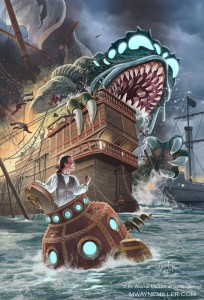
greydog: That last bit’s painfully true for many of us. Now, we never ask where people get their ideas or inspiration if we can help it – it’s a bit of a stock question. What we would like to know is how much you can get your own vision across. Do you have much creative freedom on a book commission?
mwm: Having the freedom to pursue one’s own artistic vision is not the goal of an illustrator. That is not to say an illustration is not the artistic vision of an artist, but only that the aim is to support the narrative or concept for which the work was commissioned. I never go into a job hoping to fulfil my own artistic agenda. Rather, I aim to capture the subject matter, whether idea or text, and make it a visual reality. This process is very much my own vision, and often I have full freedom to do as I wish in this endeavour, but ultimately it is the subject that dictates the result.
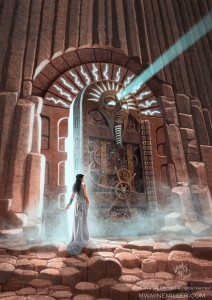
greydog: And what sort of time-scale do you allow to produce a full colour book cover from scratch?
mwm: Most of my commissions take one to two weeks. This does not include reading time for a manuscript. The concepting process is the variable, as that is the part of the job where an idea is settled upon through working with the publisher and author to clarify the rough drawing. Sometimes this process is quick and painless. Other times it is a real effort to clarify the agreed upon rough. Once painting begins, a week will suffice for most covers in an ideal world where that is the only project on my plate. The reality is that I work on more than one concurrently, with each one at different stages. This allows me to maintain an efficient workflow, and also to “get a break” from one project when I work on another.
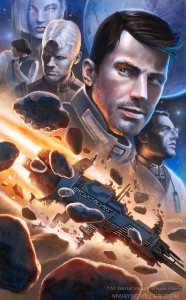
greydog: On the subject of workflow, your style would obviously be perfect for graphic novels. Have you ever considered, or been approached about, taking on that sort of work?
mwm: It has been offered, and while I would love to do such work, honestly, I don’t have the patience for sequential art. Drawing the same characters interacting is not something I am well suited for. I do enjoy inking existing sequential art, but that happens rarely. I would, however, take all the cover work for comics and graphic novels that I can get. That way I get to draw the characters in one really big detailed scene, and then I am on to something else.
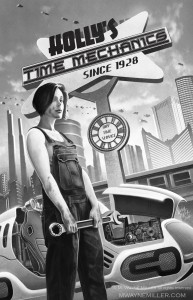
greydog: Our last shot – when the work’s over, and he wants to chill out, what does M Wayne Miller really do? Sketch, read, get the DVDs out or head for the bar like most of the greydogtales team?
mwm: Is work ever over? Ha! What down time I get usually involves reading, movies, TV, or video games, but even unrelated past times are still feeding my artistic well, so it could realistically be said I am always “on the job”. All that being said, I am not averse to having a pint at all!
greydog: Good man! And thank you very much, Wayne.

And we’re out of here, as you can see from Wayne’s illo above. I think Wayne’s the one driving. He has a website, with more illos, and links to where you can buy his prints, that you can visit here:
And for completists, Dark Renaissance Books can be found here:
Don’t forget, if you subscribe to greydogtales or follow me on facebook, you’ll never miss a post. If you don’t subscribe, I’ll just whine outside your bedroom door all night, so you might as well do it…

